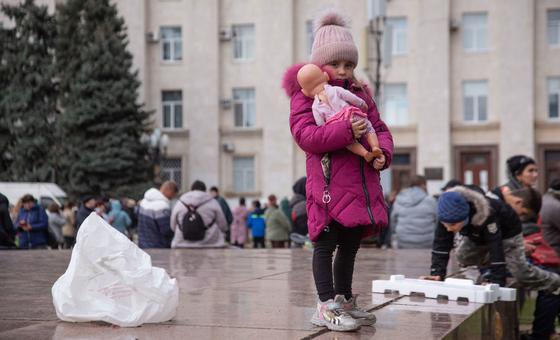
“Yet again, another unfathomable attack of the Russian Armed Forces killed and injured civilians, this time at the start of their day at a busy marketplace in Kherson City, south of Ukraine,” Matthias Schmale said in a statement.
At least five people were killed, and others injured, according to media reports.Mr. Schmale said the market and a public transport stop were also damaged.Stop attacking civiliansHe noted that since the start of the full-scale Russian invasion of Ukraine on 24 February 2022, “thousands of people going about their daily lives in markets, schools and hospitals have never returned home due to the impact of the war.”He stressed that “attacks on civilians and civilian infrastructure are strictly prohibited under international humanitarian law and must stop.”Sharp rise in casualtiesRelatedly, civilian casualties and damage to civilian infrastructure in Ukraine “increased significantly” between June and August of this year, the UN human rights office, OHCHR, said in its latest report on the country. “With 589 civilians killed and 2,685 injured from conflict-related violence between 1 June and 31 August 2024, the number of civilian casualties over this reporting period was 45 per cent higher than in the previous three-month period. July 2024 was the deadliest month for civilians in Ukraine since October 2022,” the report said. The deadliest single day was 8 July, when at least 43 civilians were killed in a large-scale coordinated missile attack, “with dozens of missiles launched by the Russian Federation against targets across Ukraine”.
© UNICEF/Oleksii Filippov
People shelter from a missile attack in a subway station in the Ukrainian capital, Kyiv.
Use of explosive weaponsMost civilian casualties, 98 per cent, were caused by the use of explosive weapons with wide area effects in populated areas. The majority, 89 per cent, occurred in territory controlled by the Government of Ukraine and 11 per cent in Russian-occupied areas. Older people, particularly women, were disproportionally affected.Russia also continued to target critical energy infrastructure during the reporting period, affecting essential services and deepening concerns, particularly with winter approaching.Kursk incursionOHCHR also noted that Ukraine’s incursion into the Kursk region of Russia on 6 August was “a significant development” during the reporting period. “While we have established some names of civilians who were killed and injured in connection with this incursion, we have not been able to establish the exact circumstances of these casualties due to lack of access and limited available public information,” Spokesperson Liz Throssell told journalists in Geneva.She said that in August, OHCHR requested Russia to facilitate access for these purposes, “but, to date, this has not been granted.”Casualties continue to mountThe UN Human Rights Monitoring Mission in Ukraine (HRMMU) verified that as of 31 August, 11,743 civilians have been killed and 24,614 injured since the conflict began.The report said that as trends continued into September, civilian casualty numbers for that month are on track to be as high as August.Intensive military efforts by Russian forces have forced the Ukrainian authorities to evacuate thousands from areas near the frontline. Meanwhile, attacks against cities across Ukraine – such as Sumy, Kharkiv, and Zaporizhzhia – have damaged and destroyed civilian property and infrastructure, including schools, hospitals, and even a geriatric care home. Further attacks against Ukraine’s energy infrastructure have also occurred.Prisoners of warThe report also covers the treatment of prisoners of war (POWs), based on hundreds of interviews. It said Ukrainian POWs have been subjected to widespread and systematic torture, and ill treatment, at the hands of Russian authorities.“They described severe beatings, electric shocks, suffocation, tasering, prolonged stress positions, sleep deprivation, dog bites, mock executions, sensory deprivation, threats, degrading treatment, and humiliation, 68% reported sexual violence,” said HRMMU chief Daniel Bell, speaking from the Ukrainian capital, Kyiv.The report said a range of factors indicate that supervisors in detention facilities were aware of this treatment and had the ability to prevent it, while some public figures in Russia have explicitly encouraged inhumane treatment, and even killing, of Ukrainian POWs “often using dehumanizing terms in public discourse and through State-owned media”.Meanwhile, Russian POWs were subjected to torture or ill-treatment by Ukrainian forces during initial stages of captivity, according to the report. This included severe beatings, threats of death and physical violence, and, to a lesser extent, electric shocks. “However, in nearly all cases, torture and ill-treatment stopped when prisoners arrived at official places of internment, where conditions appeared generally compliant with international standards,” it said. The UN High Commissioner for Human Rights, Volker Türk, will formally present the report to the UN Human Rights Council in Geneva on 8 October.

